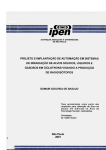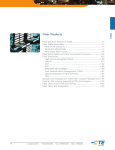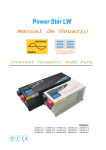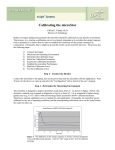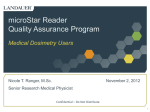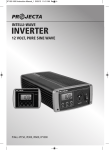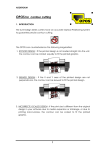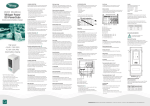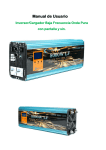Download Diodes versus Ion Chambers
Transcript
Diodes versus Ion Chambers Choosing The Right Detector For The Right Application Sun Nuclear manufactures radiation therapy quality assurance instruments using both diode and ionization chamber technology. Sun Nuclear chooses a detector type based on the application for which the instrument is intended. Our Daily QA 3™ actually uses both detector types. Applications involving the measurement of steep dose gradients require a small detector if accurate and precise measurements are desired. “For dosimetric plan verification, the expected two-dimensional distribution of the array signals is calculated via convolution of the planned dose distribution, obtained from the treatment planning system, with the two-dimensional response function of a single chamber.” B. Poppe et al, referring to PTW 2D chamber arrays “Two dimensional ionization chamber arrays for IMRT plan verification” Medical Physics, April 2006, Vol. 33 (a 4mm chamber)...“is small enough to accurately measure the profile, as long as the field size is not smaller than 4x4cm²” S. Amerio et al, original collaborators to the MatriXX “Dosimetric characterization of a larger area pixel-segmented ionization chamber” Medical Physics, February, 2004, Vol. 31 “.......a number of ADCL customers submitting PTW ionization chambers have recieved notifications that the calibration factor of thier instrument has shifted. Several of the ADCLs have reported that the response of some PTW chambers can change up to 1.4% during the first year of use. Physicists with PTW chambers are advised to monitor the response of the instrument carefully during the first year of use.” AAPM Accredited Dosimetry Calibration Laboratory Program AAPM Newsletter vol. 2306 pp. 24-25, Nov-Dec 1998 Why Chambers Are Wrong For IG/IMRT & Stereotactic QA Sophisticated treatments such as IG/IMRT and Stereotactic Radiosurgery demand accurate QA of their fields, which are collections of small beamlets with very steep dose gradients (penumbra) measuring 1 x 1cm2 or smaller. Because these dose gradients are meant to tightly conform to patient anatomy and tumor volume, accurate verification measurement of the dose gradients is of the highest importance. Special care must be taken when comparing planned dose to measured dose. If the planned dose is modeled with an ion chamber, the dose gradients will be underestimated due to dose volume averaging. If QA is performed on the same beam with ionization chambers, gradients will continue to be underestimated, hiding a critical dose non-conformity error. When ion chambers are used for both beam modeling and QA, the planned dose and measured dose may agree because they BOTH under and/or overestimate dose to the target volume and surrounding structures. The QA results may be favorable, but they are not satisfying the objective of revealing inconsistencies between the conceptual planned dose and actual delivered dose. WARNING: ! Ionization chambers have large measurement volumes and are NOT designed for accurate small field or steep dose gradient QA. Small beam models often model dose gradients and beam shape incorrectly. Attempting to discover such errors with ion chambers will merely extend the measurement error rather than reveal it. Table 1: Comparison Of Penumbra Width of A 2 x 2cm2 Field At 1.5cm Depth For A 6MV Beam IBA RK 4 (diameter) 4.6 4.2 PTW PTW PinPoint 0.125 2 (diameter) 5.5 (diameter) 4.1 5.3 3.4 6.1 Thinner Active Thickness & Volume The electrode spacing of the ion chambers used in the Scanditronix MatriXX and the PTW 729 is more than 150 times larger than the active thickness of the MapCHECK diode. If the SSD is 100cm, there could be a 1% difference in beam intensity between the top and bottom of a 5mm thick chamber. The diode is taking a point measurement at exactly the specified depth, the ion chambers are taking an average measurement along a depth range. Additionally, the volume of the MapCHECK diode is only 0.000019cm3. This is approximately 4,200 times smaller than a MatriXX chamber, and 6,500 times smaller than a PTW 729 chamber. Diode Advantage #3 Better Sensitivity A silicon pn junction diode is about 18,000 times more sensitive than the air cavity ion chamber. The MapCHECK diode has an active volume more than 4,200 times smaller than the ion chambers used in MatriXX and 729, yet its overall sensitivity to radiation is still about 10 times higher. Diode Advantage #4 Sensitivity Diode Advantage #2 Thickness Penumbra over estimation is due to the large size of the chamber. As seen in Table 2, the active detection area of a Sun Nuclear detector used in the MapCHECK is approximately 1/25th the area of a MatriXX detector (15.90mm2), and 1/39th the area of a 729 detector (25.00 mm2). Volume The Sun Nuclear detectors used in the MapCHECK™, PROFILER 2™ and TomoDose™ measure only 0.8 x 0.8mm (0.64mm2). Table 1 clearly illustrates that both the 4mm RK chamber (similar in size to the MatriXX detector) and the 5.5mm 0.125 cc chamber (similar in size to the PTW 729 detector) significantly over estimate the penumbra region by 1.7mm to 2.4mm (59% to 83%). Active Area Smaller Active Area Less Drift The diodes used in MapCHECK have less drift than the detectors used in the MatriXX and 729. Users typically calibrate MapCHECK only once per year using our patented wide field calibration procedure. The calibration takes only 15 minutes using the easy-to-follow steps in the MapCHECK software. See Case Study 2 for more details on drift. Drift (±%) Diode Advantage #1 MapCHECK Data provided by Ron Watts, Ph.D. 729 Sun Nuclear MapCHECK 0.8 x 0.8 2.9 1.0 MatriXX Manufacturer Detector Active Detector Size (mm) Measured Penumbra Width (mm) Measured Flatness (±%) Table 2: Comparison Of Active Area, Volume, & Sensitivity Advantage Manufacturer Product 1 Active Dimension (mm) Active Area (mm2) 2 Active Thickness (mm) Active Volume (cm3) 3 Sensitivity (nC/Gy) Sun Nuclear MapCHECK 0.8 x 0.8 0.64 0.03 0.000019 32.0 IBA MatriXX 4.5 (diameter) 15.90 5.0 0.08 2.4 PTW 729 5.0 x 5.0 25.00 5.0 0.125 MapCHECK MatriXX 729 3.3 Relative scale size comparison of 2D array detectors. Case Study 1 Dose Modeling The errors in Figure 1(a) are due to the fact that the radiation beam that was modeled was not reflective of the actual beam delivered to the MapCHECK. The beam model in (a) was based on scanning data from a large volume chamber. If a large chamber is used to collect the beam data for planning system beam modeling, the result will be planned dose maps that do not accurately portray the actual beam, and these inaccuracies will not be caught if the plan maps are also verified using large chambers. Diode detectors are small enough to detect these dose volume averaging errors, as demonstrated in (a) below. After determining scenario (a) was unacceptable, this institution re-modeled their small fields with a 2mm detector, and when the beam was re-measured with the MapCHECK, dose map (b) resulted, and the pass rate rose from 79% to >95%. QA measurements with large chambers will not reveal these errors; in fact it may hide the error, especially if the beam was modeled with a similarly large chamber. Figure 1: IMRT plan errors detected by MapCHECK (a) Original model 79% passed (6 mm detector) Case Study (b) New model >95% passed (2 mm detector) 2 Reproducibility In published reports, short term and long term MapCHECK diode reproducibility has been shown to be better than ion chamber arrays. Because ion chambers are typically desired for their stability, this is a significant finding and further strengthens the argument for using diode detectors. Short Term Reproducibility Long Term Reproducibility MapCHECK ± 0.15% (15 consecutive measurements)1 IBA MatriXX Unknown. Requires 15 minute warmup2 PTW 729 ± 0.50%3 MapCHECK ± 0.20% (9 months totaling approximately 50Gy)4 IBA MatriXX ± 1.30% (7 month period)5 PTW 729 ± 1% (4 month period)6 1 2 3 4 5 6 “Evaluation of a 2D diode array for IMRT quality assurance”, Daniel Létourneau, et al, Science Direct, 70(2) p199-206 2004 D Letourneau 2004 I’mRT MatriXX User Manual User Manual 2D Array Seven29 (T10024) Version 1.1 ”A 2-D diode array and analysis software for verification of intensity modulated radiation therapy delivery”, P.Jursinic, et al, Medical Physics, 30(5) p870-879 (2003) “Dosimetric characterization of a large area pixel-segmented ionization chamber”, S.Amerio, et al, Medical Physics, 31(2) p414-420 (2004) “Characterization of a 2D ion chamber array for the verification of radiotherapy treatments”, E Spezi, et al, Phys. Med. Biol. (50) p3361-3373 (2004) Frequently Asked Questions FAQ #1: Do Sun Nuclear diode detectors have a high instantaneous dose rate dependence? No. Sun Nuclear n-type diodes exhibit a sensitivity variation of only ±1% over a 600-fold change in instantaneous dose rate (diode sensitivity change from 75cm to 250cm SSD in an open beam, and also underneath the primary collimator). FAQ #2: Will I have to calibrate the diode array frequently? No. Sun Nuclear uses proprietary radiation hardened diodes. Our diode sensitivity change is less than 0.5% / kGy with a 6 MV beam, and 1.5% / kGy with a 10 MeV beam. A Sun Nuclear user typically calibrates a diode array every 1 to 2 years for a typical patient load. The patented array calibration procedure is easily performed in only 15 minutes by the user with a software wizard. There is NO need to send the unit back to the manufacturer for calibration. As seen in Case Study 2, ion chambers could have greater long-term drift than diodes. There are many factors that contribute to detector stability, such as material stability, electronic components, etc. FAQ #3: Can MapCHECK diode detectors measure in absolute dose? Yes. By following a one-minute calibration routine in the MapCHECK software, the absolute dose calibration factor is obtained for the center diode. By multiplying this absolute dose calibration factor to the array calibration factor of each diode, MapCHECK can measure absolute dose at each of its 445 detector locations. FAQ #4: What is the lifetime of the MapCHECK diodes? MapCHECK has been in use since mid 2002 and the prototypes are still in clinical use. MapCHECK diode detectors have a lifetime of more than 100 kGy, which for most centers will easily equate to more than 10 years. FAQ #5: What happens if one of my diode detectors fail? Diodes do not fail. It is a common misconception that diodes are more likely to fail than chambers. The diode detector is the simplest component on the detector array. If there is a failure, it is almost always a “channel measurement failure” and will most likely be in the measurement electronics, which are common to all array types, including ion chamber arrays. These electronic components are far more complex than a diode detector. Sun Nuclear includes a software feature to turn off a defective channel. This feature will not likely be used due to a defective diode, however it may be used if there is a channel measurement failure. FAQ #6: Is a diode more likely to fail than an ion chamber? No. A user is actually more likely to have an ion chamber failure because the leakage requirements are much more stringent for an ion chamber due to its much lower sensitivity and high voltage. Humidity and microscopic dust will have a much larger impact on ion chambers than on diodes. FAQ #7: Is energy dependence an issue for Sun Nuclear Diodes? No. With MV beams used in IMRT, the response change of the diodes with energy is negligible for the same energy beam. MapCHECK works perfectly if it is calibrated with each energy, taking only about 15 minutes. FAQ #8: What impact will temperature have on Sun Nuclear diodes? Any changes in temperature in the measurement environment will not be important since the MapCHECK can be calibrated in absolute dose immediately before the measurement session. FAQ #9: Will I get reproducible results with Sun Nuclear’s diode based instruments? Yes. Please see the case study on the preceding page. patient machine in-vivo S un Beam routine ATLAS radiosurgery DAILY PROFILER2 calc 2 PROFILER Your Most Valuable QA Tools w w w . s u n n u c l e a r. c o m Printed using best information available at the time of publication. +1 (321) 259 6862 SNCD101007





